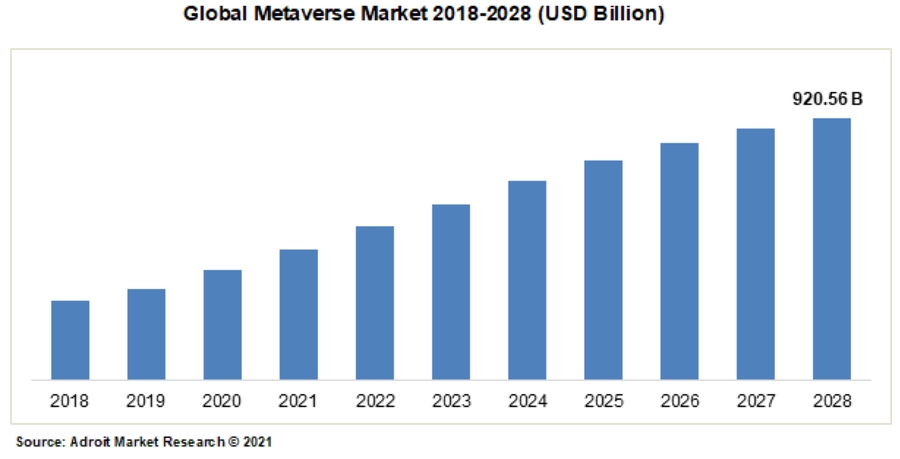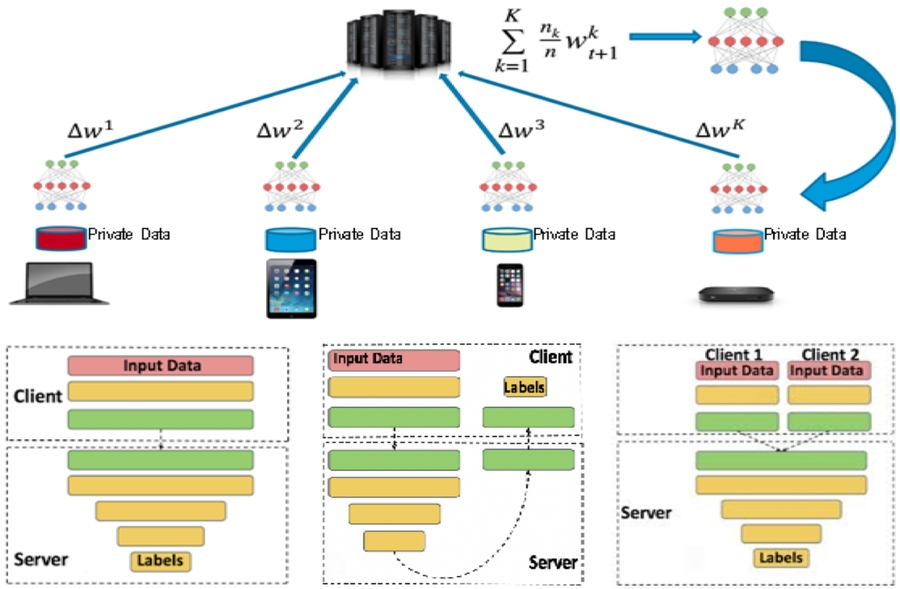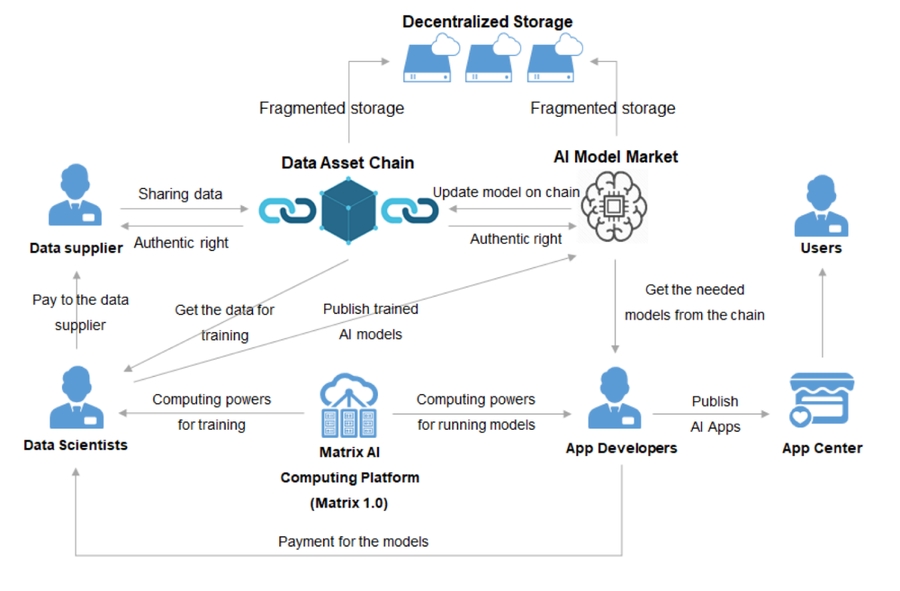Data, Computing, and Blockchain: The Fate of the Metaverse
The word “Metaverse” can be traced back to Neal Stephenson’s 1992 science fiction Snow Crash. Now three decades later, this word refers to a virtual world enabled by information technologies that is parallel to and co-existent with the physical world. It is a digital space where people live and interact under new social rules, and the migration from the physical world to the digital world is a process to be accompanied by large amounts of content creation, economic infrastructure building, user experience optimization and physical world mirroring.
The popularization of the Internet has made people’s lives increasingly digital. We depend on our smartphones for shopping, entertainment, traveling and ordering food. As we do these things, a digital world parallel to our physical world is slowly taking shape. By bringing together these fragments of data and integrating them into one digital space, we have given birth to the original Metaverse.
The outbreak of Covid-19 was another impetus for people to adopt the digital world. As we spend more time in the virtual world, big tech companies such as Microsoft, Google and Tencent saw opportunities and took the initiative. Facebook even renamed itself to Meta, pushing the Metaverse hype to a new climax.

As unicorn companies and venture capitalists all put their eggs in the Metaverse, a brand-new era is peeping around the corner.
A Projection of the Development of the Metaverse
In the short term, the use scenarios of the Metaverse will focus on revolutionizing gaming, social media and other traditional entertainment industries. At this stage, immersive content consumption will be what sets the Metaverse apart. As MR technologies and devices become maturer, people’s experience in the Metaverse could see a quantum leap, and the Metaverse will become the primary medium of entertainment for most people. The explosion of Metaverse content due to its social networking nature will ignite the demand for 5G, boosting 5G coverage to an unprecedented level.
In the middle term, the Metaverse will gradually become part and parcel of people’s work and life. Today, digital twin is already a crucial technology in the manufacturing industry. As VR, AR and cloud computing gain wider adoption, the Metaverse will feature smart cities built on virtual networks, a closed-loop virtual economic system, digital services bridging the physical and the virtual worlds as well as maturer financial tools.
In the long term, the Metaverse will bring endless possibilities, revolutionizing the way society works by integrating the virtual and the physical worlds. People today are still debating what society will look like 30 years down the road when the Metaverse has reached its full potential, fundamentally altering the way we produce, organize and connect with each other. But needless to say, technological advances are always accompanied by new situations, problems and challenges.

Blockchain: The Value Foundation of the Metaverse
Simply put, the Metaverse is a virtual world that people can migrate into and one that is parallel to the physical world. And since societies, whether real or virtual, are founded on private asset ownership, the Metaverse cannot function without this fundamental issue solved.
The once-popular MMORPG game World of Warcraft was considered by many to be a Metaverse prototype. The game created a closed-loop virtual-world economy where players can not only buy in-game stuff with the gold they farmed, but also cash out the gold and get real-world dollars. But as time went on, one problem become more and more prominent. Blizzard has stated explicitly in its terms that all in-game assets are owned by Blizzard—not the players, which sounds ridiculous considering players have invested their time and money to create these assets in the first place. Today, companies like Facebook and Amazon are building their own versions of the Metaverse, but still, these platforms are centralized and thus cannot guarantee that people truly own their digital assets.
It is therefore clear that a decentralized world enabled by blockchain is the only answer when it comes to building the Metaverse. Blockchain technologies make decentralized settlement and value transfer possible. It guarantees transparent rules and trustworthy execution, thus protecting asset ownership and the smooth transfer of value in society, laying the foundation for an efficient and stable economy. As a mega platform that hosts all the virtual activities of humanity, the Metaverse will naturally hold a monopoly over traffic. If the Metaverse were to be dominated by centralized tech companies, they will possess far greater control over society than the Internet monopoly they currently enjoy. This will hurt the long-term development of the Metaverse, while blockchain is the perfect solution for such concerns.

Without blockchain, the Metaverse will never amount to anything but a more complex version of World of Warcraft or the Sims. Blockchain is the bridge between virtual and physical worlds, so that the virtual world can truly function like a parallel universe. Thanks to blockchain, people’s virtual assets and identities will be protected, and the exchange of value will be governed by transparent rules.
Blockchain is the perfect tool for this. And to realized the full potential of the Metaverse, we will need a highly efficient blockchain platform powerful enough to host the online activities of millions of people simultaneously. And Matrix AI Network, with its AI-empowered hybrid-PoW consensus mechanism, comes to the rescue. Boasting a mainnet TPS of over 10,000, Matrix is way faster than other unsharded public chains without compromising the security of its platform.

Computing: The Metaverse’s Engine
As we know, the Metaverse utilizes AI, VR, cloud computing, digital twin, blockchain and other technologies to mirror the physical world into a virtual world made up of data connected through the Internet. Computing power is the blood of this virtual world, where the functioning of all its features and services depend on computing. Therefore, to power a virtual world large enough to accommodate all of humanity, we need huge amounts of computing power.
In the meantime, since the Metaverse needs to be a decentralized society, decentralized computing is also a must so that people’s privacy is not compromised.
Matrix AI Network has presented a perfect system of solutions. The launch of MANTA marks the world’s first decentralized computing platform built on blockchain. This removes people’s security concerns when it comes to personal information in the Metaverse. In addition, Matrix’s open-source computing power distribution platform makes it possible for people to lease out their idle computing power. The huge amount of computing power needed to support the virtual activities of humanity may be beyond any company, institution or country’s ability to provide. But with this technology, each person can use his personal PC, smart phone or iPad to generate enough computing power for his personal use. If this can be done, will a fully immersive virtual reality still be far away?

Data: The Metaverse’s Most Valuable Asset
As an ecosystem parallel to the real world, the Metaverse needs its own complete economic structure. In the real world, people put a price tag on goods and services to represent their intrinsic value so that people can buy or sell them using money as a way of exchanging value. In the Metaverse, all things are digital, and how the value of things are measured and exchanged must also be suitable for the digital world.
This means the Metaverse will depend on a closed-loop economic system to exist, and people should be able to create value in the Metaverse and build their virtual assets. The question then becomes what will Metaverse assets look like?
What is considered valuable in the Metaverse is decided by community consensus. Bitcoin is a good example. But the Metaverse is still far from maturity. We are still waiting for breakthroughs in technology and VR infrastructure such as brain-machine interface. At the current stage, it’s too early to say what form Metaverse assets will take. But we can assume, with a great degree of certainty, that one thing will still be valuable in the Metaverse in the future, and that is data, which we are already creating and will only become more valuable as time goes on.
For data to be seen as assets, two conditions have to be met first: a. reliable data ownership authentication, and b. data security.
Matrix has already built a mature system of solutions for both issues. First of all, since Matrix is a high-performance public chain, it enjoys a natural advantage in authenticating data ownership. Secondly, Matrix’s IPFS distributed storage safeguards the security of data. Last but not least, Matrix’s unique distributed computing guarantees the separation of the ownership and usage right of data so that data can exchange hands without any concerns of personal information getting leaked. With these advantages, data can truly become an important asset in the Metaverse, and a closed-loop economy will eventually take shape.

AI: Indigenous Inhabitants of the Metaverse
As one of the core pillars of the Metaverse, AI serves to maintains system stability and creates high-quality content to give people an immersive experience.
The Metaverse in turn is also the ideal environment for training AI models. This is because the Metaverse will contain large quantities of data that have been marked. These data are high-quality and directional, making them suitable for deep learning and machine learning. Moreover, the Metaverse is home to an endless variety of digital environments and countless users, which provides AI with instantaneous feedback and direction. In this sense, AI programs are the indigenous inhabitants of the Metaverse.
At the same time, people in the Metaverse will need services and content to consume in quantities exceeding what we can create for ourselves. We can confidently predict that most such content and services will come from AI.

Matrix has come up with a perfect framework of positive re-enforcement for the coexistence of AI and humanity. As the Metaverse develops, this ecosystem will also self-improve and develop into the most important indigenous inhabitant and service provider in the Metaverse.

Matrix: The Provider of Infrastructure Solutions for the Metaverse
From the core value of the Metaverse to the driving force for its growth, from its network infrastructure to the social benefits it creates, all these essential elements have completed the evolution to 1.0. Now we are knocking at the door to 2.0, and Matrix already holds the key in its palm. In this sense, the future which Matrix envisioned at its foundation in 2016 is a testament to its foresight.
Matrix’s forward-looking ways aren’t just evident when it comes to Metaverse infrastructure. Other technologies essential for the Metaverse, digital twin, for instance, have already been employed by Matrix for a long time. Matrix has many years of experience in China’s railway and defense industries. The biometric identification Matrix is developing could be the Metaverse’s only DID solution in the future.
The future of the Metaverse is beyond our imagination, and step by step, Matrix will eventually come into its own as a trustworthy infrastructure solution provider for the Metaverse.
Last updated